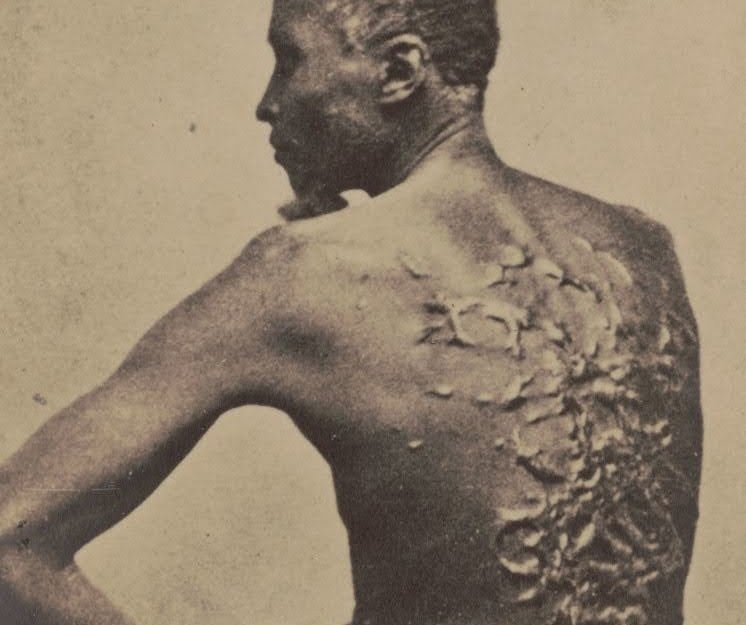"Whipped Peter" 1863, was an African American slave who escaped a Louisiana plantation in March 1863, gaining freedom when he reached the Union camp near Baton Rouge. The incredible power of this image is the dignity of that man. He& #39;s posing, expression indifferent.
1. When a slave ship arrived in the West Indies the crew prepared the Africans for sale. They washed,
shaved & rubbed them with palm oil & rust or black lead to hide any sores and some times a plug
of tar or rope was inserted into a slave’s anus to hide the signs of dysentery.
shaved & rubbed them with palm oil & rust or black lead to hide any sores and some times a plug
of tar or rope was inserted into a slave’s anus to hide the signs of dysentery.
2. Slaves were sold at auction. The ship’s gun would be fired and buyers would gather for the sale. The slaves were treated like animals, not human beings. Slaves were brought in 1 at a time and stood on a chair to be prodded poked, inspected; then sold to the highest bidder.
4. Any who were too sick to sell were left to die on the pier. Plantation owners liked to pick and choose their slaves to get a & #39;mixture& #39; of Africans from various tribes to prevent rebellions.
5. Slave families were split up and sent to different plantations
and friendships made during the voyage were also broken.
and friendships made during the voyage were also broken.
6. Immediately owners began to break in new slaves. They brutally forced Africans to adapt to new working and living conditions, learn a new language and take a new name. Many died or committed suicide. Others resisted and were punished.
7. Immediately owners began to break in new slaves. They brutally forced Africans to adapt to new working and living conditions, learn a new language and take a new name. Many died or committed suicide. Others resisted and were punished.
8. Most slaves, including women and children, worked on sugar plantations where conditions
were very harsh. They were forced to work a 12-hour day and at harvest time work was almost non-stop. Slaves were subjected to severe discipline, torture, cruelty and sexual abuse.
were very harsh. They were forced to work a 12-hour day and at harvest time work was almost non-stop. Slaves were subjected to severe discipline, torture, cruelty and sexual abuse.
9. Most slaves, including women and children were field hands. They cleared and ploughed the land. Then holes 15cm deep were dug for plants, a backbreaking task for the line of slaves who moved slowly across the field with the whips of the overseers ready to lash at them.
10. At harvest time the sugar cane was cut and tied in bundles to be carried to the mills. Sugar was made by crushing the cane then boiling the juice.
11. Slaves often had fingers trapped and crushed in the giant rollers as they fed in the cane. In the boilers, the scum that formed on top of the boiling syrup had to be ladled off, a tricky and dangerous job.
12. Working in the sugar boiling house was very unpleasant. The smell was like sickly manure & the heat was unbearable. Arms and legs swelled up in the hot, damp atmosphere & even the strongest slaves could not work in the boiling house for more than four hours
13. The slaves lived in flimsy huts that were draughty and cold in winter. They were fed only the cheapest food and meat was almost never eaten. Salt herrings from England often turned rotten before they arrived.
14. On some plantations slave families were given small gardens to grow yams and vegetables and raise pigs and poultry.
15. Some slaves tried to escape, but if caught they got no mercy from their owners, who would want to make an example of them. Terrible whippings and torture were common. Some slaves had their hands or feet cut off. Owners could also execute slaves who rebelled.
16. On average slaves in the British West Indies survived for only seven years. By that time planters calculated they had made a return on their investment.
17. An inspired man here, made the suggestion earlier that they should make a statue of Peter. I think that& #39;s an incredible idea. Let& #39;s hope there is an MP savvy enough to instigate it.  https://abs.twimg.com/emoji/v2/... draggable="false" alt="🧐" title="Gesicht mit Monokel" aria-label="Emoji: Gesicht mit Monokel">
https://abs.twimg.com/emoji/v2/... draggable="false" alt="🧐" title="Gesicht mit Monokel" aria-label="Emoji: Gesicht mit Monokel">  https://abs.twimg.com/emoji/v2/... draggable="false" alt="🌹" title="Rose" aria-label="Emoji: Rose">
https://abs.twimg.com/emoji/v2/... draggable="false" alt="🌹" title="Rose" aria-label="Emoji: Rose"> https://abs.twimg.com/emoji/v2/... draggable="false" alt="🌊" title="Wasserwelle" aria-label="Emoji: Wasserwelle">
https://abs.twimg.com/emoji/v2/... draggable="false" alt="🌊" title="Wasserwelle" aria-label="Emoji: Wasserwelle">  https://abs.twimg.com/emoji/v2/... draggable="false" alt="🦉" title="Eule" aria-label="Emoji: Eule">
https://abs.twimg.com/emoji/v2/... draggable="false" alt="🦉" title="Eule" aria-label="Emoji: Eule"> https://abs.twimg.com/emoji/v2/... draggable="false" alt="🙏" title="Folded hands" aria-label="Emoji: Folded hands">
https://abs.twimg.com/emoji/v2/... draggable="false" alt="🙏" title="Folded hands" aria-label="Emoji: Folded hands">
https://twitter.com/aedwardiansea/status/1270989140230909952?s=19">https://twitter.com/aedwardia...
https://twitter.com/AnthonyAshfiel1/status/1271005305485303809?s=19">https://twitter.com/AnthonyAs...
https://twitter.com/Jeanvaljean1533/status/1271078259829202946?s=19">https://twitter.com/Jeanvalje...
https://twitter.com/BBCNews/status/1270982031900651520?s=19">https://twitter.com/BBCNews/s...
https://twitter.com/BBCNews/status/1269925351091843075?s=19">https://twitter.com/BBCNews/s...
https://twitter.com/BBCNews/status/1269925351091843075?s=19">https://twitter.com/BBCNews/s...
https://twitter.com/Jeanvaljean1533/status/1271139687915282435?s=19">https://twitter.com/Jeanvalje...

 Read on Twitter
Read on Twitter


